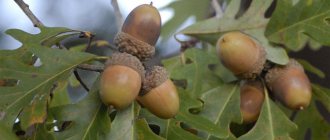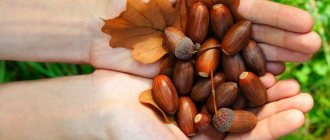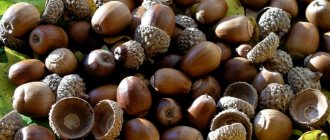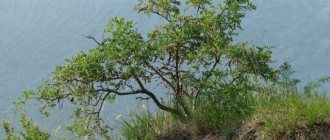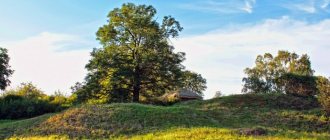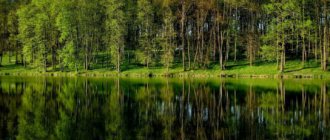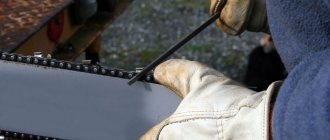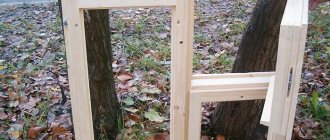There are several interesting facts about oak: At the Paris exhibition in 1900, an oak ridge was demonstrated, cut from a 485-year-old oak tree with a height of 31 m and a diameter of 169 cm. This oak was cut down in the Bolshesursky forest dacha of the Kurmysh forestry of the Simbirsk province, that is, on the territory of the modern Sumerlinsky forestry enterprise of the Chuvash Republic.
And in 1861, in the Yadrinsky district of the Kazan province, an oak tree “50 feet long” (that is, 15 m in height) and “48 inches in the top cut” (diameter 213 cm) was cut down. This tree was estimated to be 500 years old; at that time it was completely fresh, healthy and still growing in volume...
The oak was a sacred tree of many peoples, including the ancient Slavs and Celts, and was worshiped as a deity. Even today it remains a symbol of courage and perseverance, and not just, so to speak, “impenetrability”... By the way, seeing an oak tree strewn with acorns in a dream means well-being and career growth.
English oak (summer, English, common) (Quercus robur). © Leafland
Botanical description
Oak (Quercus) is a genus of deciduous or evergreen trees of the beech family. The leaves are alternate, simple, pinnately divided, lobed, toothed, sometimes entire. Oak flowers are small, inconspicuous, unisexual, monoecious; staminate - in long hanging catkins, pistillate - single or several, sessile or on a peduncle. The fruit is a single-seeded acorn, partially enclosed in a cup-shaped woody bud.
Oak grows slowly, at first (up to 80 years) - stronger in height, later - in thickness. Typically forms a deep tap root system. Produces abundant growth from the stump. Photophilous. Some types of oak are drought-resistant, quite winter-hardy and have little demands on soils. It begins to bear fruit from 15 to 60 years of age, in open areas earlier than in plantations. It reproduces mainly by acorns. For sowing, acorns collected in the same year are used, because they quickly lose their viability. There are about 450 species of oak in the temperate, subtropical and tropical zones of the Northern Hemisphere. In Russia there are 20 (according to other sources, 11) wild species in the European part, the Far East and the Caucasus; 43 species of oak trees are grown in cultivation.
Of greatest importance in forestry is the English oak , or summer oak (Quercus robur), a tree up to 40-50 m high and 1-1.5 m in diameter. The leaves are elongated, obovate, with 5-7 pairs of short lobes, on petioles up to 1 long. see Acorns 1-3 on the stalk. It blooms simultaneously with the leaves blooming from 40-60 years. Fruits abundantly every 4-8 years. With side shading it grows quite quickly, but requires good lighting from above. Lives up to 400-1000 years. Distributed in the European part of Russia, the Caucasus and almost throughout Western Europe. In the northern part of the range it grows along river valleys, to the south it reaches watersheds and forms mixed forests with spruce, and in the south of the range there are pure oak forests; in the steppe zone it is found in ravines and ravines. One of the main forest-forming species of broad-leaved forests in Russia.
Close to the English Oak is the Sessile Oak , or Winter Oak (Q. petraea), with almost sessile (2-3) acorns, found in the west of the European part of Russia, in the Crimea and the North Caucasus. In the eastern part of the North Caucasus and Transcaucasia, the Georgian oak (Q. iberica) grows with leathery leaves and sessile (1-2) acorns; In the high-mountain belt of these regions, large-anthered oak (Quercus macranthera) grows with densely pubescent shoots and acorns that are sessile or on a short stalk. The main species of valley forests in Eastern Transcaucasia is long-legged oak (Q. longipes). An important forest-forming species of the Far East is the Mongolian oak (Q. mongolica) - a frost-resistant and drought-resistant tree.
Oak wood has high strength, hardness, durability and beautiful texture (pattern on the section). It is used in shipbuilding and underwater structures, because does not rot; used in carriage building, furniture, carpentry, cooperage, house construction, etc. The bark of some species ( Cork Oak - Q. suber) produces a cork. The bark and wood contain tannins (tannids) used to tan leather. The dried bark of young branches and thin trunks of the English oak is used as an astringent in the form of an aqueous decoction for rinsing in inflammatory processes in the mouth, pharynx, pharynx, as well as for lotions in the treatment of burns. Acorns are used as a substitute for coffee and as feed for pigs and some other agricultural products. animals. Many species, such as chestnut oak (Q. castaneifolia), are grown in gardens and parks as ornamental plants.
Planting an acorn
For a young sprout, fertile soil rich in nutrients is essential. It is important to plant it in moist soil taken from under the mother tree.
Take a large disposable cup and make several holes in its bottom for drainage. Then it is filled with prepared soil. In which we carefully place the sprouted acorn at a depth of 3 cm. Cover the glass with damp gauze and place it on the windowsill.
Growing oak
Oak acorns, unlike the seeds of the vast majority of our other trees, do not remain viable when dried and stored for a long time at room temperature. Therefore, it is necessary either to sow them in the fall before snow falls and the soil freezes, or to provide them with special storage conditions. Autumn sowing is the simplest, but there is a serious risk of damage to some of the acorns by rodents.
For spring sowing, oak acorns must be properly preserved. The best storage conditions are created at low (about 0° or slightly higher) temperature, high humidity and moderate ventilation. Acorns can be stored in the basement, in which potatoes are well preserved in winter; You can also bury them in the fall into the soil to a depth of at least 20 cm, covering the top with a sheet of waterproof material, leaving a layer of air between this sheet and the acorns and providing protection from mice. In any case, healthy acorns without external damage should be stored for winter, preferably collected in dry weather and dried at room temperature for a week. Any special preparation of seeds that have survived the winter before sowing is not required.
Before sowing, evaluate the quality of the acorns by opening several of them. Living oak acorns have yellow cotyledons, and at the point where they connect to each other there is a living (yellow or red-yellow) embryo. Dead acorns are black or gray inside. It is not always possible to distinguish living acorns from dead ones by external signs. Soaking acorns in a container of water gives good results - dead acorns mostly float, live acorns mostly sink (if there are a lot of acorns, then this method of separating the dead from the living can be recommended, but a small part of the living acorns will be lost).
If you were unable to stock up on acorns in the fall, then in some years (after a large harvest of acorns and in the event of a “failure” of mice, and if the winter was not very frosty) you can collect live and germinating acorns in the nearest forest or park. It is necessary to collect germinating acorns early in the spring, almost immediately after the snow melts, otherwise you will find damaged roots in many acorns. Collected oak acorns must either be sown immediately or stored until sowing in such a way that the roots do not dry out (for example, mixed with wet leaves in a plastic box placed in a refrigerator or cold basement). Even during short-term storage, care must be taken to ensure that germinating acorns do not become moldy (damaged ones should be thrown away immediately), and ventilation should be ensured. The faster you can sow the acorns collected in the spring, the more of them will be able to develop into seedlings.
Oak acorns. © Twid
Sprouted oak acorn. © Beentree
Sowing acorns
When sowing acorns, mark parallel furrows on the bed at a distance of 15–25 cm from each other. Place acorns in the furrows at the rate of 15–50 pieces. per 1 m of furrow length, depending on the quality and size (if the acorns are large and almost all are alive, then they should be laid out less often, if they are small and with a large proportion of dead and doubtful ones, they should be placed more densely). If you plan to plant annual oak seedlings in a permanent place, then acorns should be sown even less often - at a distance of 7-10 cm from each other (this will ensure maximum growth of each tree). Press the acorns into the bottom of the furrow so that they are at a depth of 2–3 cm relative to the soil surface when planting in spring and 3–6 cm when planting in autumn. After this, level the furrow by covering the acorns with soil.
Acorns take a very long time to germinate. First, they develop a powerful root, reaching a length of several tens of centimeters, and only after that the stem begins to grow. Therefore, oak sprouts can appear on the soil surface only a month and a half after the start of germination. Do not rush to conclude that your oak trees are dead and dig up the bed with crops (as the experience of novice amateur foresters shows, this happens). If in doubt, try digging up a few acorns. If their roots have grown, then the acorns are alive.
Caring for oak seedlings
Oak seedlings suffer significantly less from weeds and soil drying out than coniferous tree seedlings (thanks to the supply of nutrients in the acorn, large roots and leaves immediately develop). However, try to always keep the crops free of weeds and provide water during severe drought, especially if you want to produce large seedlings in one year. Stop all additional watering about a month and a half before the time when massive leaf fall begins in your area - this will allow oak seedlings to better prepare for wintering (oak growth that is too late often freezes in winter).
In summer, oak seedlings are often affected by powdery mildew, a fungal disease. Powdery mildew is not capable of killing oak seedlings, but can significantly reduce their growth. If powdery mildew develops strongly (if a white coating covers more than half the area of all leaves), the seedlings can be treated with a 1% solution of copper sulfate or a 1% sulfur suspension. Oak seedlings can be grown for two years in one place without transplanting, or they can be transplanted into a “school” in the second year. The second method is preferable, since it allows the formation of a more compact and branched root system, which suffers less when transplanted to a permanent place (in two-year-old seedlings grown without replanting, the length of the main root can be more than a meter, and it is almost impossible to replant them without damaging the root).
Transplanting oak seedlings into a “school” should be done in the spring, preferably as early as possible, so that the root system damaged during replanting has time to partially recover before the leaves bloom (it is also important that the soil is still moist during replanting). When replanting, cut the main root of each oak seedling at a distance of 15-20 cm from the place where the acorn was located (in most seedlings, the remains of the acorn are still visible in the second year). This will allow the formation of a more compact root system. You can not cut off the main root, but in this case it will be very difficult to dig up two-year-old seedlings without seriously damaging their root system.
Oak seedlings. © Elektryczne jabłko
In the “school”, place rows of seedlings at a distance of 25–30 cm from each other, and seedlings in a row – at intervals of 12–15 cm. When planting under each oak seedling, make a hole 20–25 cm deep with a stake or the handle of a shovel (the depth of the hole should be such that when planting the seedling, the place of attachment of the acorn is 2–3 cm below the soil surface). Insert the seedlings into the holes (the main root of oak seedlings, unlike the roots of conifers, is hard and straight and is inserted into the holes without problems). Then fill the holes with soil and compact it with your hands so that the soil fits more tightly to the roots of the seedlings.
In the first weeks after transplantation, transplanted oak seedlings suffer greatly from root damage - the leaves bloom quite slowly, and the growth of shoots is relatively small. Nevertheless, by mid-summer the normal development of seedlings is restored, and by autumn, as a rule, large seedlings (30–50 cm high) are obtained that are quite suitable for planting in a permanent place. If the size of the seedlings by autumn leaves much to be desired, then only the largest ones can be selected for transplantation, and the rest left in the “school” for another year.
If you are transplanting annual oak seedlings to a permanent location (this is quite possible if planting is done in areas with low grass cover or on plowed soil), then do not cut the main roots of the seedlings - try to preserve as much of their length as possible. The root system of an annual oak seedling is represented mainly by a long and straight taproot with weak and short lateral roots, so for replanting it is enough to make a narrow hole of appropriate depth using a stake or a shovel handle.
Acorn selection
Before planting an oak tree from an acorn, it is important to find a healthy, mature tree of large size to select planting material from. In autumn, ripe acorns fall along with the leaves. Several dozen acorns are selected. It is important that they are intact, without any damage. When shaking, the inner kernel should not hit the walls of the shell.
You should also pick up fallen leaves and fertile soil. This will help preserve the material. Arriving home, the acorns are lowered into water, and the specimens that float up are thrown away. Only those that remain at the bottom of the container after several checks are retained.
Types of oak
English oak (summer, English, or common) - Quercus robur
It is found naturally in the European part of Russia, Central and Western Europe. A very powerful tree up to 50 m tall, in closed plantings with a slender trunk, highly cleared of branches, in single plantings in open areas - with a short trunk and a wide, spreading, low-set crown. Lives 500-900 years.
English oak (Quercus robur). © 2micha
The bark on trunks up to 40 years is smooth, olive-brown, later grayish-brown, almost black. The leaves are alternate, close together in bunches at the top of the shoots, leathery, oblong, obovate, up to 15 cm long, with an elongated apex and 3-7 pairs of blunt, lateral lobes of unequal length. The blades are entire or with 1-3 teeth, often with ears at the base of the leaf blade. The leaves are shiny, bare, dark green above, lighter below, sometimes with sparse hairs. In spring, the oak blooms late, one of the last among our trees. The oak tree blooms in April-May, when it still has very small leaves. The flowers are unisexual, monoecious, very small and inconspicuous. Male or staminate flowers are collected in peculiar inflorescences - long and thin, yellowish-greenish hanging earrings, reminiscent of hazel earrings. Acorns up to 3.5 cm, 1/5 covered with plus, ripen in early autumn.
Grows slowly, maximum growth energy in 5-20 years. It is moderately light-loving and, thanks to its powerful root system, is wind-resistant. It does not tolerate excessive soil moisture, but can withstand temporary flooding for up to 20 days. It prefers deep, fertile, fresh soils, but is able to grow in any soil, including dry and saline soils, which makes it indispensable in green construction in many regions of Russia. It has high drought and heat resistance. One of the most durable breeds, some sources indicate a life expectancy of up to 1500 years.
Has powerful energy. Oak in Rus' was considered a sacred tree. In springs located in oak forests, the water has an excellent taste and is particularly clean.
Propagated by sowing acorns, decorative forms by grafting and green cuttings. Renews well with growth from the stump. Acorns do not tolerate drying out; as soon as they lose even a small part of the water, they die. They rot easily in warm conditions and are very sensitive to cold and frost. This circumstance presents a certain difficulty in preserving acorns for seeds. In nature, there is no such problem: acorns that fall in the forest in late autumn overwinter in a damp litter of leaves under a thick layer of snow, which protects them from both drying out and frost. The germination of an acorn resembles the germination of a pea: its cotyledons do not rise above the soil surface, like many plants, but remain in the ground. A thin green stalk rises up. At first it is leafless, and only after some time small leaves appear on its top.
Red oak (Quercus rubra)
In nature, it is found along the banks of rivers, where there is no stagnation of water in the soil, north of the 35th parallel of the North American continent, up to Canada. Tree up to 25 m in height.
A slender tree with a dense tent-shaped crown.
Red oak (Quercus rubra). © Jean-Pol GRANDMONT
The trunk is covered with thin, smooth, gray bark, cracking in old trees. Young shoots are reddish-felt, annual shoots are reddish-brown, smooth. The leaves are deeply notched, thin, shiny, up to 15-25 cm, with 4-5 pointed lobes on each side of the leaf, reddish when blooming, dark green in summer, lighter below, scarlet-red in autumn, before falling, in young trees , in old ones - brownish-brown. It blooms simultaneously with the leaves blooming. Acorns are spherical in shape, up to 2 cm, red-brown, as if chopped off at the bottom; unlike pedunculate oak, they ripen in the fall of the second year. Fruits steadily and abundantly from 15-20 years. When young it grows faster than European oaks.
Frost-resistant. Moderately light-loving, easily tolerates lateral shading, but prefers full illumination of the crown top. Not drought resistant. It is wind-resistant, not very demanding on soil fertility, can withstand even acidic reactions, however, does not tolerate calcareous and wet soils. Resistant to pests and diseases, including powdery mildew - the scourge of our oaks. Has high phytoncidal properties. Due to its high decorative value, resistance to adverse environmental factors, and magnificent autumn decoration, it deserves the widest use in green construction, for creating single and group plantings, alleys, arrays, lining roads and streets.
Downy oak (Quercus pubescens)
In nature, it is found in the southern Crimea, the northern part of Transcaucasia, southern Europe and Asia Minor. Tree up to 10 m tall. Durable.
Downy oak (Quercus pubescens). © Petr Filippov
Significantly inferior in size to previous species, with a low, winding trunk and a wide crown, sometimes even a shrub. Young shoots are heavily pubescent. Leaves are 5-10 cm long, very variable in shape and size, with 4-8 pairs of blunt or pointed lobes, dark green above, glabrous, below gray-green, pubescent. The scales of the plush surrounding the acorn are also fluffy.
It grows slowly, is light- and heat-loving, lives on dry rocky slopes and soils containing lime. Tolerates haircuts well. A valuable species for green building in arid areas, it grows on rocky soils where other species do not develop. An excellent material for tall hedges and curly, trimmed forms.
White oak (Quercus alba)
Homeland - eastern North America. Grows in forests along with other species of oak and hazel, on various soils, but better on deep, rich, well-drained, limestone soils; in the north of the range it extends no higher than 200 m above sea level. sea, in the south up to 1500 m above sea level. seas.
White oak (Quercus alba). ©Msact
A large beautiful tree up to 30 m, with powerful spreading branches forming a wide, tent-shaped crown. The shoots are bare, the trunk bark is gray, shallowly cracking. Remarkable for its very large, oblong-oval leaves, up to 22 cm, with 5-9 blunt lobes; when blooming - bright red, in summer - bright green, with a whitish-gray underside. In autumn, the leaves turn dark red or violet-purple. Acorns up to 2.5 cm, covered by a quarter of the plus. Seeds are stored for spring sowing in semi-moist sand. In autumn, they are sown immediately after harvesting and air drying. Seed germination remains until the spring of next year. Soil germination 80 - 85%. Embedment depth c. 5 - 6 cm.
Swamp oak (Quercus palustris)
Homeland North America.
A slender tree up to 25 m tall, in youth with a narrow pyramidal crown, later with a broad pyramidal crown. Young shoots are thin, hanging, reddish-brown. The bark of the trunk is greenish-brown and remains smooth for a long time. Leaves are up to 12 cm long, with 5-7 deeply cut serrated lobes, almost to the middle of the leaf, bright green above, lighter below, with tufts of hairs in the corners of the veins. In autumn - bright purple. Acorns are sessile, almost spherical, up to 1.5 cm, covered by 1/3 plus. Seeds are stored for spring sowing in semi-moist sand. In autumn s. sown after harvesting and air drying. Seed germination remains until the spring of next year. Soil germination s. 80 - 90%. Embedment depth c. 5 - 6 cm.
Swamp oak (Quercus palustris). © Willow
It grows quickly and is less frost-hardy than red oak and northern oak. It is more demanding of soil and its moisture, as it naturally grows in deep, moist soils of river banks and swamps. Tolerates city conditions well. Looks great in single, group and alley plantings, along the banks of reservoirs. In culture since the middle of the 18th century. Grows in parks of Ukraine (Chernivtsi), Belarus, Voronezh region. It's freezing in St. Petersburg.
Willow oak (Quercus phellos)
Grows wild in eastern North America.
A beautiful deciduous tree up to 20 m tall, with a slender trunk and a wide-round (pyramidal in youth) crown. Remarkable for its original shiny green leaves, reminiscent of willow leaves (up to 12 cm in length and 2 cm in width). This similarity is even stronger in young leaves, which are heavily pubescent underneath. In autumn, the leaves turn a dull yellow color.
Willow oak (Quercus phellos). © Daderot
It is characterized by rapid growth, light-loving, unpretentious to the soil, tolerates temperatures down to -23 ºС. Used in single and group plantings. In culture since 1680.
Holm oak (Quercus ilex)
Homeland Mediterranean, Southern Europe, North Africa, Asia Minor.
An evergreen tree up to 25 m tall, with a smooth dark gray trunk and a dense, wide-spreading crown. The shoots are grayish-tomentose, the leaves are small, up to 8 cm, highly variable in shape, leathery, shiny, dark green, yellowish or whitish-pubescent below. Acorns ripen in the second year.
It is recommended to store freshly harvested acorns in trenches. The permissible period of dry storage is until next spring. Acorns are stratified in moderately moist sand for 2 - 3 months at 2 - 5 ° C, then sown in greenhouses or ridges, where they germinate for 20 - 30 days at 0 - 15 ° C. Embedment depth c. 4 - 7 cm.
Holm oak (Quercus ilex). © propio
It grows quickly, is quite shade-tolerant, frost-resistant, and can withstand temperatures down to -20°C without damage. Drought resistant. Grows on dry rocky slopes and all types of soil. It tolerates haircuts well and is durable. A valuable, beautiful breed for park construction in the south of Russia. It is good in group, alley and street plantings, in regular gardens - for creating dense high hedges and high walls, for which its small-leaved forms are suitable. In culture since 1819.
Chestnut oak (Quercus castaneifolia)
Grows wildly in Armenia, the Caucasus and Northern Iran. Listed in the Red Book of the USSR. Protected in the Girkansky Nature Reserve. Forms pure forests or with an admixture of other deciduous species on the ridge crests. Photophilous mesoxerophyte.
Tall, up to 30 m, a beautiful tree with a slender trunk, the bark of which remains smooth for a long time, with a wide tent-shaped crown and large leaves, reminiscent of chestnut leaves, up to 18 cm long, with large, sharp, triangular teeth. The leaves are matte, dark green, almost bare on top; below are finely pubescent, grayish-white. Acorns up to 3 cm, 1/3 covered with plus.
Chestnut oak (Quercus castaneifolia). © Mmparedes
It grows relatively quickly, is moderately frost-resistant, and not drought-resistant enough. Good for alleys, group and single plantings of parks and forest parks. Suitable for cultivation in the southwestern and southern parts of Russia, on the Black Sea coast. In culture since 1830.
Large-fruited oak (Quercus macrocarpa)
A North American species that grows as a tree up to 30 m high, with a thick trunk and a spreading, tent-shaped crown. The bark on the trunk is light brown, cracking. The leaves are obovate, oblong, up to 25 cm long, deeply lobed; shiny, dark green above, whitish-green, pubescent below, acquiring a spectacular yellow-brown color in autumn. Acorns are oval, large, up to 5 cm, 1/3 covered with plus.
Seeds are stored for spring sowing in semi-moist sand in the basement. In autumn, the seeds are sown after collection and air drying. Seed germination remains until the spring of next year. Soil germination 80 - 85%. The seeding depth is 5 - 6 cm.
Large-fruited oak (Quercus macrocarpa). © Daderot
Its growth rate is almost equal to that of pedunculate oak; in terms of frost resistance it is close to it and to red oak, but is more moisture-loving than these species. Decorative, used in green building, like other types. In culture since 1826.
Preparing material for planting
It's time to look at how to grow an oak tree. Before planting, 90 days before planting, acorns must be removed from storage, wiped with a dry cloth, and an external inspection must be performed for possible damage. They are placed in a humid environment (a jar of damp sphagnum moss) and refrigerated until roots emerge.
Diseases and pests of oak
The most dangerous diseases are plant wood. Infectious diseases affecting wood are divided into two groups. Non-rot diseases include cancerous ulcers and tumors, vascular diseases of trunks and branches, necrosis of bark and sapwood. Diseases of this group affect the most important tissues of trunks and branches and, when severely developed, lead to drying out of trees. Cancerous ulcers and tumors develop and spread slowly and are usually caused by fungi and bacteria. Vascular diseases develop and spread quickly and can lead to drying out of trees in a few years or months. Necrosis of trunks and branches can also form extensive areas of drying out. Their spread is ensured by the ability of pathogens to accumulate huge amounts of infection in the dead tissues of affected trees. The causative agents of necrosis are also semi-parasitic imperfect and marsupial fungi, and sometimes bacteria. Rot diseases include wood rot of branches and trunks, root and butt rot.
Gallica
By autumn, oak leaves often develop yellowish or yellow-pink balls - galls - the size of a small cherry. They look like tiny apples with a regular spherical shape.
Galls are painful growths of leaf tissue. The gall midge insect, which looks like a very small fly, is to blame for their appearance. The gall midge pierces the skin of the leaf with a thin, sharp ovipositor and lays an egg there. Some time after this, a “ball” grows on the leaf. If you break such a ball in late autumn, in the middle you can find a small white worm - a gall midge larva - or an adult insect. In some years, oak leaves are literally covered with galls - there are several of them on each leaf.
Gall on an oak leaf. © Fritz Geller-Grimm
Gall on an oak tree. © Rasbak
Gall on an oak tree. ©Saharadesertfox
Galls are sometimes called ink nuts. This name is not accidental. Our ancestors in the time of Pushkin used them to prepare black ink. How do you get ink this way? You need to prepare a decoction of nuts and add a solution of iron sulfate to it. By merging two weakly colored liquids, we obtain a completely black liquid. This chemical “trick” is explained simply. Gall contains a lot of tannins, and they have the ability, when combined with iron salts, to give a thick black color. The same can be done with tea infusion (it also contains a lot of tannins). If you add a few drops of a yellowish solution of ferric chloride to a glass of weak tea, the liquid becomes completely black.
Oak pests
Leaf-gnawing and stem pests, and fungal diseases are the most important factor increasing the drying out of oak stands. Violation of the ecological balance of oak phytocenoses, especially in oak forest monocultures, leads to disturbances in the water regime of territories, changes in light and temperature conditions in the plantation, and all together to the formation of conditions more favorable for the development of pests and diseases.
Oak is damaged by a huge number of pests and diseases. Different authors give different figures on the number of pests and diseases that damage oak. In the Tellerman forest, 184 species of foliage pests have been identified (Molchanov, 1975). Among the most common pests that damage foliage are: 5 species of silkworms, 5 species of cutworms, 6 species of moths, 8 species of moths, 8 species of sawflies, 2 species of leaf rollers, 11 species of gall moths, 2 species of psyllids, 5 species of weevils, 2 species hermes, 2 types of aphids and 3 types of plant mites. Buds and flowers are damaged by 12 species of gallworms. Acorns are damaged by 2 species of codling moths, 3 species of weevils and 1 species of gall moth. The trunk and branches are damaged by 8 species of bark beetles, 7 species of longhorned beetles, 3 species of horntails, 2 species of woodworms, 1 species of flat-footed beetles, 3 species of borers, 1 species of the borer family, 1 species of wood borers (Napalkov, 1953).
Sawfly caterpillars on oak leaves. © Beentree
In Europe, 542 species of harmful insects that damage oak have been identified (Hrast Luznjak..., 1996). A total of 206 species of fungi were discovered, including zygomycetes - 3 species, mastigomycetes - 2 species, ascomycetes - 50 species, basidiomycetes - 43 species, deuteromycetes - 108 species. 1 virus was detected - tobacco mosaic virus (TMV), 14 species of bacteria (Erwinia quercicola Geprges et Bad., Erwinia valachika Geprges et Bad., Pseudomonas quercus Schem, etc.). However, the influence of viruses and bacteria as causes of oak decline has not been clearly established (Ragazzi et al., 1995).
Acorn wintering
Take a glass jar. The above foliage and soil are placed in it and mixed thoroughly. Place acorns in the middle of the container and cover them with this soil. The jar does not close tightly, it must breathe.
The material is placed in the refrigerator and stored at a temperature of 2 degrees Celsius throughout the winter.
Transplanting a seedling
In the first 10 years, oak grows up to 35 cm per year, then its growth slows down. When it is 15 cm tall, when the stem has already formed and the first leaves have appeared, it needs to be transplanted to a new permanent place.
Any transplant is stressful and must be approached step by step. First of all, in the spring, we take the pot with the seedling outside for a few minutes. Every day this time doubles until the plant can stay outside around the clock.
